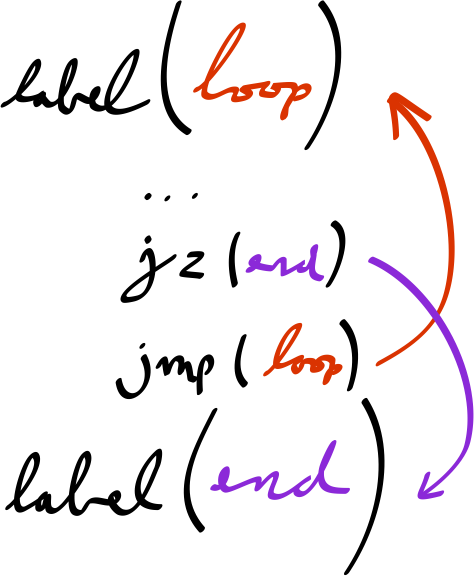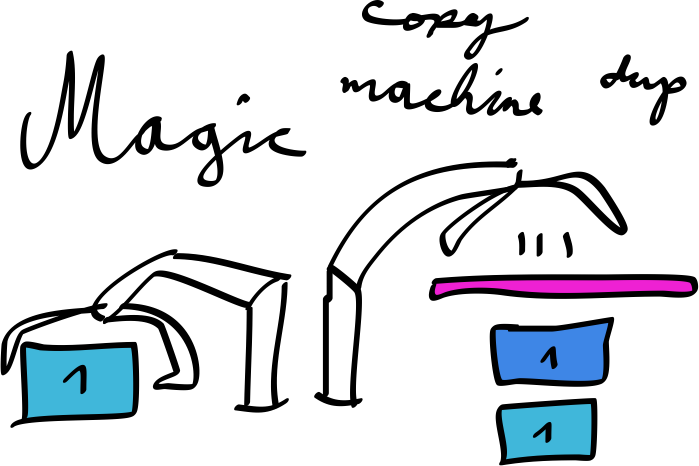Stack Machines: Conditionals
fundamentals << rpn-calculator << shunting-yard << io << jumps << conditionals << comments << calls << variables << stack-frames << heap << compilers
In previous posts, we have seen that stack machines can be extended with I/O and unconditional jumps to create infinite loops. However, it is not possible to break out of those loops. What a vicious cycle indeed.
We will now take a look at conditional branching as a way of solving this issue, and creating many new ones.
To jump or not to jump
One of the most important tools of the modern software maker is the conditional jump. It is the building block out of which conditional expressions, if statements and loops are formed.
The conditional jump is the decision maker, the control structure responsible for change.
A conditional jump will only perform a jump if a certain condition is met. The first such conditional jump instruction is jump if zero, also known as jz. It will pop a value from the stack, and if that value is zero, jump. Otherwise, it will fall through.

jz, Jay-Z... Get it? I'll show myself out.
Here we have a typical do while loop, implemented using jz:

Other conditional branching operations include: jump if not zero, jump if equal, jump if not equal, and many more.
Duplication
There are different ways in which conditional jumps can be implemented. Since the approach in this post will consume the top of the stack, it will be useful to have a way to duplicate the topmost element of the stack. That allows values to be preserved across conditional jumps.
For this, we can introduce a dup instruction. Its usage would look something like this:
1 dup +
This will push 1 onto the stack, duplicate the 1 (pushing a copy of it), then pop the two 1s and push their sum. Which is 2. In case you didn't know.
The implementation of dup is straightforward:
switch ($op) {
// ...
case 'dup':
$stack->push($stack->top());
break;
}
It turns out that dup is a magic copy machine.

Implementation
Based on the implementation of jmp:
if (preg_match('/^jmp\((.+)\)$/', $op, $match)) {
$label = $match[1];
$ip = $labels[$label];
continue;
}
It is quite easy to make this jump conditional based on a popped value:
if (preg_match('/^jz\((.+)\)$/', $op, $match)) {
$label = $match[1];
if ($stack->pop() === 0) {
$ip = $labels[$label];
}
continue;
}
It is literally the same as jmp, with an added if statement!
Here is another gif, for your viewing pleasure:

Output loop
Let us revisit the "hello world" example from the I/O post.
104 . 101 . 108 . 108 . 111 . 44 . 32 . 119 . 111 . 114 . 108 . 100 . 10 .
It pushes the ASCII codes for the string in order and prints them. Would it not be great to extract the outputting logic into a loop?
It can be done. First of all, all characters will be stored on the stack. Because it is a stack, elements are consumed in reverse order of being pushed. This means we need to reverse the order here. There also needs to be a zero at the bottom of the stack (pushed first) that will mark the end of the string.
0 10 100 108 114 111 119 32 44 111 108 108 101 104
label(loop)
dup jz(end)
.
jmp(loop)
label(end)
This loop will output the characters on the stack until it hits a 0, at which point the jz will jump out of the loop to the end label.
It is equivalent to a while loop, and as a matter of fact, compilers will compile while statements to assembly of roughly the same shape as the above.
Implications
The implications of this change are huge. This machine is much more powerful than all of the previous ones. The reason is that now the execution of the program can change over time. You can now actually break out of loops, allowing them to terminate once some condition is met.
The conditional jump can be used to implement all of the control structures that you know and love: if, while, for, etc.
The conditional jump goes to infinity, but only sometimes. This makes programs unpredictable. But awesomely powerful.

Summary
Adding conditional jumps to an RPN calculator allows it to perform conditional logic and break out of loops.
fundamentals << rpn-calculator << shunting-yard << io << jumps << conditionals << comments << calls << variables << stack-frames << heap << compilers
